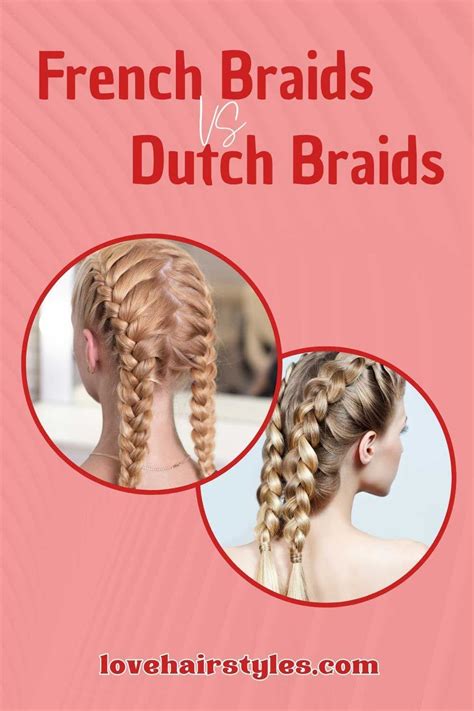Introduction
French braids and Dutch braids are two of the most popular and versatile braiding techniques, both known for their intricate designs and timeless elegance. While both styles may appear similar at first glance, there are subtle differences in their construction that result in distinct looks and benefits. In this comprehensive guide, we will delve into the world of French and Dutch braids, exploring their history, techniques, applications, and everything in between.

Understanding the Difference
French Braid (or “Classical Braid”)
- Origin: Believed to have originated in Africa and brought to Europe by French soldiers in the 17th century.
- Technique: Crosses the outermost strands of hair over the center strand, creating a woven appearance.
- Appearance: Results in a flat, smooth braid with a visible braid pattern on the top.
Dutch Braid
- Origin: Also known as the “inverse French braid,” it emerged in the Netherlands.
- Technique: Crosses the outermost strands under the center strand, creating a raised and voluminous effect.
- Appearance: Produces a thicker, more prominent braid with the criss-cross pattern displayed on the bottom.
Step-by-Step Guide: Braiding Techniques
French Braid
- Brush your hair thoroughly to remove any tangles.
- Section off a small portion of hair at the crown and divide it into three equal strands.
- Cross the right strand over the center strand.
- Cross the left strand over the new center strand (previously the right strand).
- Continue adding small sections of hair from the sides into the outermost strands before crossing them over.
- Repeat steps 3-5 until you reach the nape of your neck.
- Braid the remaining hair into a regular three-strand braid.
- Secure with a hair elastic or ribbon.
Dutch Braid
- Follow steps 1-2 for the French braid.
- Cross the right strand under the center strand.
- Cross the left strand under the new center strand (previously the right strand).
- Continue adding small sections of hair from the sides into the outermost strands before crossing them under.
- Repeat steps 3-4 until you reach the nape of your neck.
- Braid the remaining hair into a regular three-strand braid.
- Secure with a hair elastic or ribbon.
Applications and Benefits
Applications:
- French Braid: Weddings, proms, festivals, daily wear
- Dutch Braid: Sports, casual outings, hair updos
Benefits:
-
French Braid:
- Creates a sleek, sophisticated look
- Prevents flyaways and hair breakage
- Adds volume and length to fine hair
-
Dutch Braid:
- Provides a fuller, more voluminous braid
- Ideal for thick, heavy hair
- Can be used to create intricate updos
Why It Matters
Braiding has been a cultural and social practice for centuries across various civilizations. French braids and Dutch braids hold historical and aesthetic significance, representing both tradition and contemporary styling techniques. They continue to be popular choices for everyday wear, special occasions, and artistic expressions.
Pros and Cons
French Braid
Pros:
– Classic and elegant look
– Suitable for all hair types
– Relatively easy to master
Cons:
– Can be time-consuming on thicker hair
– May lack volume on fine hair
Dutch Braid
Pros:
– Adds fullness and volume to hair
– Provides a secure hold for physical activities
– Can be used to create unique updos
Cons:
– More challenging to braid initially
– May not suit all face shapes
Variations and Creativity
Beyond the basic techniques, there are countless variations and creative applications for French and Dutch braids. Experimentation and personalization are encouraged to create unique and eye-catching hairstyles.
Tables for Practical Reference
Table 1: Comparison of French and Dutch Braids
| Feature | French Braid | Dutch Braid |
|---|---|---|
| Technique | Crosses outermost strands over | Crosses outermost strands under |
| Appearance | Flat, smooth, visible braid pattern on top | Raised, voluminous, braid pattern on bottom |
| Difficulty | Moderate | Slightly more challenging |
| Hairstyle Applications | Weddings, proms, daily wear | Sports, casual outings, updos |
Table 2: Benefits of French and Dutch Braids
| Feature | French Braid | Dutch Braid |
|---|---|---|
| Prevents flyaways | Yes | Yes |
| Adds volume to fine hair | Yes | Yes, to a greater extent |
| Suitable for thick hair | Yes | Yes, especially beneficial |
| Can be used to create updos | Yes | Yes, especially for intricate styles |
Table 3: Step-by-Step Instructions for French and Dutch Braids
| Braiding Pattern | French Braid | Dutch Braid |
|---|---|---|
| Step 1 | Divide hair into three strands | Divide hair into three strands |
| Step 2 | Cross right strand over center | Cross right strand under center |
| Step 3 | Cross left strand over center | Cross left strand under center |
| Step 4 | Continue adding hair from sides and crossing strands over | Continue adding hair from sides and crossing strands under |
Table 4: Hair Types Suitable for French and Dutch Braids
| Hair Type | French Braid | Dutch Braid |
|---|---|---|
| Fine hair | Adds volume and length | May lack volume |
| Medium hair | Suitable for both braids | Ideal for either braid |
| Thick hair | Suitable, may lack volume | Adds fullness and volume |
Conclusion
French braids and Dutch braids offer versatile and timeless styling options for all hair types and occasions. Whether you prefer the classic elegance of the French braid or the voluminous fullness of the Dutch braid, mastery of both techniques empowers you to create stunning hairstyles that express your personal style. Embrace the beauty of braids and let your creativity shine!
